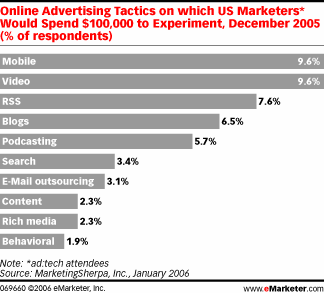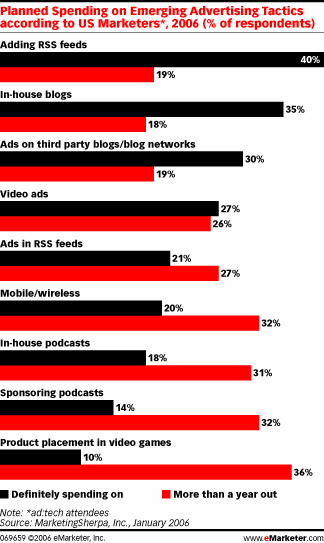Tourism marketing, particularly destination marketing, is heavily information dependant. In once sense, our primary mission is the gathering and dissemination of relevant data. Witness our massive lodging and events databases. Over at Microperuasion, Steve Rubel notes an interesting article at eMarketer which points to some advertising trends in the mobile communications market.
Things are moving quickly in regards to the ever changing information channels presented by the internet. Traditional travel marketing channels are evolving daily as saavy users seek other ways to get information when and where they need it. At the same time, the growing information overload and multiple available sources force users to seek more focused and relevant places to get what they need. Enter the growing Web 2.0 movement.
Take a look at the following poll results:
 When I look at that, I see the disturbing fact that the top five are not even on the radar for most destination marketers I know. Travel marketing is clearly no longer the trend-setter in terms of technology and distribution like it used to be.
When I look at that, I see the disturbing fact that the top five are not even on the radar for most destination marketers I know. Travel marketing is clearly no longer the trend-setter in terms of technology and distribution like it used to be.
The incredible growth in the mobile communications market and similarly the massive leap that socially distributed video is making, is worthy of note. Granted, we in the North Country are not in the same category as a concentrated urban environment, so our needs are not the same. We don’t even have mobile coverage over 100% of our area. However this won’t last forever. Most importantly though, our target markets are using this technology. Especially the huge cohort of echo-boomers which form our future markets. I can see in the future some integration of mobile technology and podcasting as ways of enhancing on-site visitor information needs – both in terms of distribution of tourism products, but also interpretive material. Immediately though, the use of RSS and Blogging platforms may allow destination marketers to complement the static/evergreen content with ‘fresh’ and timely information that can be pushed to relevant information networks. Another interesting chart details the planned technology and marketing expenditures in these advertising areas.
 Wow, this is like the roadmap for tourism that I have in my brain, I just don’t have any money to spend. Fortunately, for small organizations, it is not necessary to spend all that much to get your foot into these marketing channels.
Wow, this is like the roadmap for tourism that I have in my brain, I just don’t have any money to spend. Fortunately, for small organizations, it is not necessary to spend all that much to get your foot into these marketing channels.
I’m a huge fan of the WordPress blogging platform. Mainly because it is free, functional, and something I can tinker with. But also for its potential as a low-cost CMS and/or traditional website replacement. I think more and more ‘on the ground’ or trusted information is being demanded by the consumer. But even the large recommendation networks, ie Tripadvisor, are being undermined and consumers are increasingly turning to each other directly for information.
Enter the blog. Simply attaching a blog to an existing site gives the ability to join the Web 2.0 scene. Add that with liberal and judicious use of tagging and social networking tools. Immediately the destination blogger now can create relevant and viral content to complement the existing static travel data. All the email newsletter content can now be served via a newsfeed. The best part is that this can easily be accomplished, and at the cost of only time. The hard part is the motivation and will of the organization to recognize and implement these efforts.
More Information:
Micro Persuasion: Blog, RSS Marketing Picking Up Steam







No Comments so far ↓
There are no comments yet...